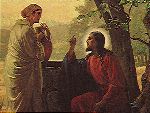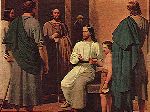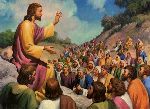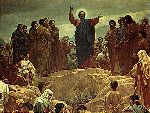
Jesus Leadership Style |
||
|
This module is a self-guided bible study, looking at several gospel events, which seek to build our understanding of the way that Jesus exercised servant leadership. Our hope is that by posing some questions to aid reflection, you might get some insights into how Jesus exercised leadership during his ministry. | |
| Before we start... Firstly, spend a moment reflecting on whether you feel
comfortable that Jesus did exercise leadership, by considering the following elements of
some common leadership definitions. The concensus of leadership literature suggests
that leaders have vision, are individuals who attract followers, are people who share
their vision with their followers, and enable the group together to achieve the common
goal. |
||
| Pause
for Thought : Now pause for a moment, and take each of the following seven
descriptors in turn, and think through to what degree you would associate them with Jesus.
(rank each on a 1 to 7 scale, where 1 would be no association at all, and 7 would be a
total association.) visionary, strategist, team leader, servant leader, shepherd, trainer, encourager. Now put this piece of paper away - you will return to it later. |
||
| Seven Reflections on Jesus' Leadership Style: | ||
| The Disciples. Taking the list given in Matthew (10:2-4), work through your knowledge of the 12, writing down for each their skills/experiences, and also their character traits. What would you see as the strengths and weaknesses of choosing this particular team of 12? How does Jesus bond them together into a cohesive team? |
|
|
| Sending out of the 12 and the 72. (Luke 9 to Luke 10:24). Why do you think Jesus sent the disciples out at this stage of his ministry? What was Jesus' possibly trying to achieve by it? What relevance to the narratives of the feeding of the five thousand and Peter's confession of Christ have to the sending out of the twelve? Why do you think Jesus sent the 72 out in pairs? What might we surmise from Jesus sending out the 12 before sending out the 72? | ||
Jesus the Teacher. Jesus taught throughout the gospels - to the crowds, to individuals such as Nicodemus, the woman at the well, the rich young ruler, and to the disciples. Following through Luke's gospel, look at each time Jesus was teaching, and jot down the context (individual / disciples / group) and his style (formal / parable / individual discipling). Finally reflect on your own teaching, and the range of contexts and styles that you use. |
|
|
| Clearing the Temple. (John 2 : 12-22) This gospel account suggests that Jesus' driving out of the money lenders was a pre-meditated action. He went up to the Temple and was appalled at what he found. He then made a whip from cords and drove the merchants and their cattle from the Temple area, and overturned the tables of the money changers. What does this tell us about Jesus' leadership style. In what situations might we be prepared to adopt a similar approach? | ||
| The Road to Emmaus (Luke 24:13-35) In walking along with the Cleopas and his companion, Jesus met them at their point of need, journeyed with them, teaching them as he did so, without them recognising him. Can you think of leadership situations where you might walk alongside others, gently and almost imperceptibly teaching and leading them. |
|
|
| With Pilate (Luke 23:1-25, John 18:28 - 19:16) One of the traits of a leader is their ability to influence others; by their words, by their actions, and by their character. In what ways does Jesus influence Pilate? What does this have to suggest about the nature of Christian leadership? | ||
| The Great Commission (Matthew 28:16-end, Acts 1:1-11) Jesus leaves his disciples with the commission to spread the good news throughout the world. In this commission, Jesus gives vision (what they will achieve) and strategy (how they should achieve the vision). Re-read the passages, separating out the vision Jesus lays before the disciples and the strategies he urges them to follow. We also see Jesus choosing strategies throughout his ministry, in choosing ordinary people to be his disciples, and in standing outside the established church. |
|
|
| Pause
for Thought : Now you have reflected on these scripture passages,
repeat the initial exercise, and rank the following seven descriptors again. Have
any of your scores changed? If so, in what way has your understanding of Jesus'
servant leadership changed? Finally, what has surprised you in this exercise? How might this influence your perception of your own leadership? |
||





